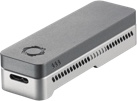cDNA-PCR sequencing - sequence-specific (SQK-PCS111)
- Home
- Documentation
- cDNA-PCR sequencing - sequence-specific (SQK-PCS111)
MinION: Protocol
cDNA-PCR sequencing - sequence-specific (SQK-PCS111) V CPSS_9185_v111_revD_19Apr2023
The fastest and simplest protocol for targeted cDNA sequencing
- Higher yields than traditional cDNA synthesis
- Splice variants and fusion transcripts
- Compatible with R9.4.1 flow cells
For Research Use Only
This is a Legacy product This kit is soon to be discontinued and we recommend all customers to upgrade to the latest chemistry for their relevant kit which is available on the Store. If customers require further support for any ongoing critical experiments using a Legacy product, please contact Customer Support via email: support@nanoporetech.com.
FOR RESEARCH USE ONLY
Contents
Introduction to the protocol
Library preparation
- 4. Reverse transcription and strand-switching
- 5. Selecting for full-length transcripts by PCR
- 6. Adapter addition
- 7. Priming and loading the SpotON flow cell
测序及数据分析
故障种类及处理方法
概览
The fastest and simplest protocol for targeted cDNA sequencing
- Higher yields than traditional cDNA synthesis
- Splice variants and fusion transcripts
- Compatible with R9.4.1 flow cells
For Research Use Only
This is a Legacy product This kit is soon to be discontinued and we recommend all customers to upgrade to the latest chemistry for their relevant kit which is available on the Store. If customers require further support for any ongoing critical experiments using a Legacy product, please contact Customer Support via email: support@nanoporetech.com.
1. Overview of the protocol
重要
This is a Legacy product
This kit is soon to be discontinued and we recommend all customers to upgrade to the latest chemistry for their relevant kit which is available on the Store. If customers require further support for any ongoing critical experiments using a Legacy product, please contact Customer Support via email: support@nanoporetech.com. For further information on please see the product update page.
cDNA-PCR Sequencing Kit features
This kit is highly recommended for users who:
- Would like to identify and quantify full-length transcripts
- Are looking for a faster and simpler method for cDNA synthesis: ~210 minutes library prep + variable time for PCR
- Want to explore isoforms, splice variants and fusion transcripts using full-length cDNAs
- Wish to start from total RNA or have a low starting amount of RNA
- Would like to generate high amounts of cDNA data
Introduction to cDNA-PCR protocol
This protocol outlines a targeted cDNA sequencing method using the cDNA-PCR Sequencing Kit (SQK-PCS111) and a user-defined sequence-specific primer. You can swap out the cDNA RT Adapter (CRTA) and design your own primer to target a specific RNA sequence during reverse transcription. During the strand-switching step, a UMI is incorporated before the double-stranded cDNA is amplified by PCR using primers containing rapid attachment chemistry. The rapid sequencing adapters are then added to the amplified sample.
Steps in the sequencing workflow:
Prepare for your experiment You will need to:
- Extract your RNA, and check its length, quantity and purity. The quality checks performed during the protocol are essential in ensuring experimental success.
- Ensure you have your sequencing kit, the correct equipment and third-party reagents.
- Download the software for acquiring and analysing your data.
- Check your flow cell to ensure it has enough pores for a good sequencing run.
**Library preparation** You will need to:
- Perform reverse transcription with sequence-specific primer.
- Using the strand-switching protocol, prepare full-length cDNAs from your RNA sample.
- Amplify the samples by PCR, adding rapid attachment primers during the PCR step.
- Ligate sequencing adapters to the PCR products.
- Prime the flow cell, and load your cDNA library into the flow cell.
Sequencing and analysis You will need to:
- Start a sequencing run using the MinKNOW software, which will collect raw data from the device and will basecall the reads.
- (Optional) Start the EPI2ME software and select a workflow for further analysis, e.g. metagenomic analysis or drug resistance mapping
重要
Compatibility of this protocol
This protocol should only be used in combination with:
- cDNA-PCR Sequencing Kit (SQK-PCS111)
- R9.4.1 flow cells (FLO-MIN106)
- Flow Cell Wash Kit (EXP-WSH004)
2. Equipment and consumables
材料
- 4 ng enriched RNA (Poly(A)+ RNA or ribodepleted) or 200 ng total RNA
- cDNA-PCR Sequencing Kit (SQK-PCS111)
- Custom-ordered sequence-specific primer
耗材
- Agencourt AMPure XP beads (Beckman Coulter™ cat # A63881)
- 1.5 ml Eppendorf DNA LoBind tubes
- 0.2 ml thin-walled PCR tubes
- Nuclease-free water (e.g. ThermoFisher, AM9937)
- Freshly prepared 70% ethanol in nuclease-free water
- 10 mM dNTP solution (e.g. NEB N0447)
- LongAmp Hot Start Taq 2X Master Mix (NEB, M0533)
- Maxima H Minus Reverse Transcriptase (200 U/µl) with 5x RT Buffer (ThermoFisher, cat # EP0751)
- RNaseOUT™, 40 U/μl (Life Technologies, cat # 10777019)
- Exonuclease I (NEB, Cat # M0293)
- Qubit RNA HS Assay(RNA高灵敏度检测)试剂盒(ThermoFisher,Q32852)
- Qubit dsDNA HS Assay(双链DNA高灵敏度检测)试剂盒(ThermoFisher,Q32851)
- Qubit™ 分析管(Invitrogen, Q32856)
仪器
- Hula混匀仪(低速旋转式混匀仪)
- 适用于1.5ml Eppendorf 离心管的磁力架
- 迷你离心机
- 涡旋混匀仪
- 热循环仪
- P1000 移液枪和枪头
- P200 移液枪和枪头
- P100 移液枪和枪头
- P20 移液枪和枪头
- P10 移液枪和枪头
- P2移液枪和枪头
- 盛有冰的冰桶
- 计时器
- Qubit荧光计(或用于质控检测的等效仪器)
- Pre-chilled freezer block at -20° C for 200 µl tubes (e.g. Eppendorf cat # 022510509)
可选仪器
- Agilent Bioanalyzer (or equivalent)
For this protocol, you will need 4 ng enriched RNA (Poly(A)+ RNA or ribodepleted) or 200 ng total RNA.
Sequence-specific primer sequence
The cDNA RT Adapter (CRTA) supplied in the cDNA-PCR Sequencing Kit (SQK-PCS111) is designed to ligate to poly(A) tailed RNAs. However, you can design your own primer to target a specific RNA sequence (for example, to only sequence 16S rRNA) for subsequent cDNA sequencing.
To perform this type of targeting, order the oligo below, replacing the [sequence-specific] region with ~22 bases complementary to the 3' end of your target RNA sequence. Please note that the exact number of bases may need to be optimised depending on the sequence targeted.
5' - ACTTGCCTGTCGCTCTATCTTC - [sequence-specific] - 3'
We recommend starting with a stock concentration of 2 μM. However, you may find it useful to perform a titration of different primer concentrations. All primers should be HPLC purified.
起始RNA
选择符合质量和浓度要求的起始RNA至关重要的。使用过少或过多的RNA,或者质量较差的RNA(如,高度碎片化、或含有化学污染物的RNA)都会影响文库制备。
有关如何对DNA样品进行质控,请参考起始DNA/RNA质控。
有关使用RNA作为起始材料的更多信息,请参阅以下链接:
您亦可在纳米孔社区的DNA/RNA Handling 页面找到上述文件。
第三方试剂
Oxford Nanopore Technologies推荐您使用本实验指南中提及的所有第三方试剂,并已对其加以验证。我们尚未对其它替代试剂进行测试。
我们建议您按制造商说明准备待用的第三方试剂.
重要
Rapid Adapter T (RAP T) used in this kit and protocol is not interchangeable with other sequencing adapters.
cDNA-PCR Sequencing Kit (SQK-PCS111) contents
| Name | Acronym | Cap colour | No. of vials | Fill volume per vial (µl) |
|---|---|---|---|---|
| Strand Switching Primer II | SSPII | Violet | 1 | 20 µl |
| RT Primer | RTP | Yellow | 1 | 10 µl |
| cDNA RT Adapter | CRTA | Amber | 1 | 10 µl |
| Rapid Adapter T | RAP T | Green | 1 | 10 µl |
| Annealing Buffer | AB | Orange | 1 | 10 µl |
| cDNA Primer | cPRM | White cap, grey label | 1 | 40 µl |
| Elution Buffer | EB | Black | 1 | 500 µl |
| Short Fragment Buffer | SFB | Clear | 1 | 1,800 µl |
| Sequencing Buffer II | SBII | Red | 1 | 500 µl |
| Loading Beads II | LBII | Pink | 1 | 360 µl |
| Loading Solution | LS | White cap, pink label | 1 | 400 µl |
| Flush Buffer | FB | Blue | 6 | 1,170 µl |
| Flush Tether | FLT | White cap, purple label | 1 | 200 µl |
3. 计算机要求及软件
MinION Mk1B的IT配置要求
请为MinION Mk1B配备一台高规格的计算机或笔记本电脑,以适配数据采集的速度。您可以在MinION Mk1B的IT配置要求文件中了解更多。
MinION Mk1C的IT配置要求
MinION Mk1C是一款集计算功能和触控屏幕于一体的便携式测序分析仪,它无需依赖任何额外设备,即可生成并分析纳米孔测序数据。您可以在 MinION Mk1C的IT配置要求文件中了解更多。
Software for nanopore sequencing
MinKNOW
The MinKNOW software controls the nanopore sequencing device, collects sequencing data and basecalls in real time. You will be using MinKNOW for every sequencing experiment to sequence, basecall and demultiplex if your samples were barcoded.
For instructions on how to run the MinKNOW software, please refer to the MinKNOW protocol.
EPI2ME (optional)
The EPI2ME cloud-based platform performs further analysis of basecalled data, for example alignment to the Lambda genome, barcoding, or taxonomic classification. You will use the EPI2ME platform only if you would like further analysis of your data post-basecalling.
For instructions on how to create an EPI2ME account and install the EPI2ME Desktop Agent, please refer to the EPI2ME Platform protocol.
测序芯片质检
我们强烈建议您在开始测序实验前,对测序芯片的活性纳米孔数进行质检。质检需在您收到MinION /GridION /PremethION测序芯片12周之内进行,或者在您收到Flongle测序芯片四周内进行。Oxford Nanopore Technologies会对活性孔数量少于以下标准的芯片进行替换** :
| 测序芯片 | 芯片上的活性孔数确保不少于 |
|---|---|
| Flongle 测序芯片 | 50 |
| MinION/GridION 测序芯片 | 800 |
| PromethION 测序芯片 | 5000 |
** 请注意:自收到之日起,芯片须一直贮存于Oxford Nanopore Technologies推荐的条件下。且质检结果须在质检后的两天内递交给我们。请您按照 测序芯片质检文档中的说明进行芯片质检。
4. Reverse transcription and strand-switching
材料
- 4 ng enriched RNA (Poly(A)+ RNA or ribodepleted) or 200 ng total RNA
- Custom-ordered sequence-specific primer
- Strand Switching Primer II (SSPII)
耗材
- Nuclease-free water (e.g. ThermoFisher, cat # AM9937)
- 10 mM dNTP solution (e.g. NEB cat # N0447)
- Maxima H Minus Reverse Transcriptase (200 U/µl) with 5x RT Buffer (ThermoFisher, cat # EP0751)
- RNaseOUT™, 40 U/μl (Life Technologies, cat # 10777019)
- 1.5 ml Eppendorf DNA LoBind离心管
- 0.2 ml thin-walled PCR tubes
- Qubit RNA HS Assay(RNA高灵敏度检测)试剂盒(ThermoFisher,Q32852)
- Qubit™ 分析管(Invitrogen, Q32856)
仪器
- 迷你离心机
- 热循环仪
- P1000 移液枪和枪头
- P200 移液枪和枪头
- P100 移液枪和枪头
- P20 移液枪和枪头
- P10 移液枪和枪头
- P2移液枪和枪头
- Qubit荧光计(或用于质控检测的等效仪器)
- Pre-chilled freezer block at -20° C for 200 µl tubes (e.g. Eppendorf cat # 022510509)
Thaw the following reagents and spin down briefly using a microfuge, before mixing as indicated in the table below, and place on ice.
| Reagent | 1. Thaw at room temperature | 2. Briefly spin down | 3. Mix well by pipetting |
|---|---|---|---|
| Custom-ordered sequence-specific primer | ✓ | ✓ | ✓ |
| Strand Switching Primer II (SSPII) | ✓ | ✓ | ✓ |
| RNaseOUT | Not frozen | ✓ | ✓ |
| 10 mM dNTP solution | ✓ | ✓ | ✓ |
| Maxima H Minus Reverse Transcriptase | Not frozen | ✓ | ✓ |
| Maxima H Minus 5x RT Buffer | ✓ | ✓ | Mix by vortexing |
Prepare the RNA in nuclease-free water.
- Transfer 4 ng Poly(A)+ RNA, or 200 ng total RNA into a 1.5 ml Eppendorf DNA LoBind tube
- Adjust the volume to up to 9 μl with nuclease-free water
- Mix by flicking the tube to avoid unwanted shearing
- Spin down briefly in a microfuge
Prepare the following reaction in a 0.2 ml PCR tube:
| Reagent | Volume |
|---|---|
| RNA | 9 μl |
| Custom-ordered sequence-specific primer, diluted to 2 μM | 1 μl |
| 10 mM dNTPs | 1 μl |
| Total volume | 11 μl |
轻弹离心管以充分混合,并瞬时离心。
Incubate at 65°C for 5 minutes and then snap cool on a pre-chilled freezer block for 1 minute.
To the same 0.2 ml PCR tube, add the following:
| Reagent | Volume |
|---|---|
| Maxima H Minus 5x RT Buffer | 4 μl |
| RNaseOUT | 1 μl |
| Nuclease-free water | 1 μl |
| Strand Switching Primer II (SSPII) | 2 μl |
| Total (including all reagents) | 19 μl |
提示
Strand Switching Primer II (SSPII) base pairs to the deoxycytidine present at the 5' end of the first cDNA strand synthesised. This allows the reverse transcriptase to "strand-switch" for synthesis of the second cDNA strand.
轻弹离心管以充分混合,并瞬时离心。
Incubate at 42°C for 2 minutes in the thermal cycler.
Add 1 µl of Maxima H Minus Reverse Transcriptase. The total volume is now 20 µl.
轻弹离心管以充分混合,并瞬时离心。
Incubate using the following protocol using a thermal cycler:
| Cycle step | Temperature | Time | No. of cycles |
|---|---|---|---|
| Reverse transcription and strand-switching | 42°C | 90 mins | 1 |
| Heat inactivation | 85°C | 5 mins | 1 |
| Hold | 4°C | ∞ |
步骤结束
Take your samples forward into the next step. However, at this point it is also possible to store the sample at -20°C overnight.
5. Selecting for full-length transcripts by PCR
材料
- cDNA Primer (cPRM)
- Elution Buffer (EB)
耗材
- Nuclease-free water (e.g. ThermoFisher, cat # AM9937)
- LongAmp Hot Start Taq 2X Master Mix (NEB, M0533)
- Exonuclease I (NEB, Cat # M0293)
- Agencourt AMPure XP beads (Beckman Coulter™ cat # A63881)
- Freshly prepared 70% ethanol in nuclease-free water
- 1.5 ml Eppendorf DNA LoBind 离心管
- Qubit dsDNA HS Assay(双链DNA高灵敏度检测)试剂盒(Invitrogen, Q32851)
- Qubit™ 分析管(Invitrogen, Q32856)
仪器
- 热循环仪
- 涡旋混匀仪
- Hula混匀仪(低速旋转式混匀仪)
- 适用于1.5ml Eppendorf 离心管的磁力架
- 盛有冰的冰桶
- P1000 移液枪和枪头
- P200 移液枪和枪头
- P100 移液枪和枪头
- P20 移液枪和枪头
- P10 移液枪和枪头
- P2移液枪和枪头
- Qubit荧光计(或用于质控检测的等效仪器)
- Agilent Bioanalyzer (or equivalent)
重要
The 22.5 μl of reverse-transcribed sample is used to make 4x 50 μl PCR reactions which will be pooled at a later stage, with 5 μl of reverse-transcribed sample in each PCR reaction. Do NOT use all 22.5 μl of the reverse transcription reaction in a single PCR reaction.
Reverse transcriptase is a PCR inhibitor and the RT material must be diluted enough for PCR to take place.
Thaw the cDNA Primer (cPRM), Elution Buffer (EB). LongAmp Hot Start Taq 2X Master Mix and Exonuclease I at room temperature, spin down and pipette mix. Store the reagents on ice.
Spin down the reverse-transcribed RNA sample.
Prepare four fresh 0.2 ml PCR tubes and add 5 μl of reverse-transcribed sample per tube.
In each of the 0.2 ml PCR tubes containing the reverse-transcribed sample, prepare the following reaction at room temperature:
| Reagent | Volume |
|---|---|
| Reverse-transcribed sample (from previous step) | 5 μl |
| cDNA Primer (cPRM) | 1.5 μl |
| Nuclease-free water | 18.5 μl |
| 2x LongAmp Hot Start Taq Master Mix | 25 μl |
| Total (including all reagents) | 50 μl |
Mix gently by pipetting.
Amplify using the following cycling conditions.
| Cycle step | Temperature | Time | No. of cycles |
|---|---|---|---|
| Initial denaturation | 95°C | 30 secs | 1 |
| Denaturation | 95°C | 15 secs | 10-18* |
| Annealing | 62°C | 15 secs | 10-18* |
| Extension | 65°C | 60 secs per kb | 10-18* |
| Final extension | 65°C | 6 mins | 1 |
| Hold | 4°C | ∞ |
*We recommend 14 cycles as a starting point. However, the number of cycles can be adjusted between the values shown according to experimental needs.
For further information, please read The effect of varying the number of PCR cycles in the PCR-cDNA Sequencing Kit document.
Add 1 μl Exonuclease I directly to each PCR tube. Mix by pipetting.
提示
Exonuclease I is added to remove any excess primers which have not successfully annealed.
Incubate the reaction at 37°C for 15 minutes, followed by 80°C for 15 minutes in the thermal cycler.
Pool the four PCR reactions (total 204 μl) in a clean 1.5 ml Eppendorf DNA LoBind tube.
Resuspend the AMPure XP beads by vortexing.
Add 160 µl of resuspended AMPure XP beads to the reaction.
Incubate on a Hula mixer (rotator mixer) for 5 minutes at room temperature.
Prepare 1 ml of fresh 70% ethanol in nuclease-free water.
Spin down the sample and pellet on a magnet. Keep the tube on the magnet, and pipette off the supernatant.
Keep the tube on the magnet and wash the beads with 500 µl of freshly-prepared 70% ethanol without disturbing the pellet. Remove the ethanol using a pipette and discard.
重复上述步骤。
将离心管瞬时离心后置于磁力架上。用移液枪吸走残留的乙醇。让磁珠在空气中干燥约30秒,但不要干至表面开裂。
Remove the tube from the magnetic rack and resuspend pellet in 12 µl of Elution Buffer (EB).
Incubate at room temperature for 10 minutes.
Pellet the beads on the magnet until the eluate is clear and colourless.
Remove and retain 12 µl of eluate into a clean 1.5 ml Eppendorf DNA LoBind tube.
- Remove and retain the eluate which contains the cDNA library in a clean 1.5 ml Eppendorf DNA LoBind tube
- Dispose of the pelleted beads
For each sample, analyse 1 µl of the amplified cDNA for size, quantity and quality using a Qubit fluorometer and Agilent Bioanalyzer (or equivalent) for a QC check.
重要
Sometimes a high-molecular weight product is visible in the wells of the gel when the PCR products are run, instead of the expected smear. These libraries are typically associated with poor sequencing performance. We have found that repeating the PCR with fewer cycles can remedy this.
Take forward 15-25 fmol of amplified cDNA and make the volume up to 11 μl in Elution Buffer (EB).
| Mass | Molarity if fragment length = 0.5 kb | Molarity if fragment length = 1.5 kb | Molarity if fragment length = 3 kb |
|---|---|---|---|
| 5 ng | 16 fmol | 5 fmol | 3 fmol |
| 10 ng | 32 fmol | 11 fmol | 5 fmol |
| 15 ng | 49 fmol | 16 fmol | 8 fmol |
| 20 ng | 65 fmol | 22 fmol | 11 fmol |
| 25 ng | 81 fmol | 27 fmol | 13 fmol |
| 50 ng | 154 fmol | 51 fmol | 26 fmol |
If the quantity of amplified cDNA is above 25 fmol, the remaining cDNA can be frozen and stored for another sequencing experiment (in this case, library preparation would start from the Adapter Addition step). We recommend avoiding multiple freeze-thaw cycles to prevent DNA degradation.
The new sequencing adapter used in Kit 11 chemistry has a higher capture rate, enabling lower flow cell loading amounts to give optimal pore occupancy.
提示
文库保存建议
若为 短期 保存或重复使用(例如在清洗芯片后再次上样),我们建议将文库置于Eppendorf LoBind 离心管中 4℃ 保存。 若为一次性使用且储存时长 __超过3个月__,我们建议将文库置于Eppendorf LoBind 离心管中 -80℃ 保存。
6. Adapter addition
材料
- Rapid Adapter T (RAP T)
- Elution Buffer (EB)
耗材
- 1.5 ml Eppendorf DNA LoBind tubes
仪器
- 迷你离心机
- 盛有冰的冰桶
- P1000 移液枪和枪头
- P200 移液枪和枪头
- P100 移液枪和枪头
- P20 移液枪和枪头
- P10 移液枪和枪头
- P2移液枪和枪头
重要
Rapid Adapter T (RAP T) used in this kit and protocol is not interchangeable with other sequencing adapters.
Spin down the Rapid Adapter T (RAP T) and place on ice.
Add 1 μl of Rapid Adapter T (RAP T) to the amplified cDNA library.
Mix well by pipetting and spin down.
Incubate the reaction for 5 minutes at room temperature.
Spin down briefly.
步骤结束
The prepared library is used for loading onto the flow cell. Store the library on ice until ready to load.
提示
文库保存建议
若为 短期 保存或重复使用(例如在清洗芯片后再次上样),我们建议将文库置于Eppendorf LoBind 离心管中 4℃ 保存。 若为一次性使用且储存时长 __超过3个月__,我们建议将文库置于Eppendorf LoBind 离心管中 -80℃ 保存。
7. Priming and loading the SpotON flow cell
材料
- Flush Buffer (FB)
- Flush Tether (FLT)
- Loading Beads II (LBII)
- Sequencing Buffer II (SBII)
- Loading Solution (LS)
耗材
- 1.5 ml Eppendorf DNA LoBind 离心管
- 无核酸酶水(如ThermoFisher,AM9937)
仪器
- MinION device
- MinION 及GridION 测序芯片遮光片
- SpotON Flow Cell
- P1000 移液枪和枪头
- P100 移液枪和枪头
- P20 移液枪和枪头
- P10 移液枪和枪头
提示
Priming and loading a MinION flow cell
We recommend all new users watch the 'Priming and loading your flow cell' video before your first run.
Using the Loading Solution
We recommend using the Loading Beads II (LBII) for loading your library onto the flow cell for most sequencing experiments. However, if you have previously used water to load your library, you must use Loading Solution (LS) instead of water. Note: some customers have noticed that viscous libraries can be loaded more easily when not using Loading Beads II.
Thaw the Sequencing Buffer II (SBII), Loading Beads II (LBII) or Loading Solution (LS, if using), Flush Tether (FLT) and one tube of Flush Buffer (FB) at room temperature before mixing the reagents by vortexing and spin down at room temperature.
To prepare the flow cell priming mix, add 30 µl of thawed and mixed Flush Tether (FLT) directly to the tube of thawed and mixed Flush Buffer (FB), and mix by vortexing at room temperature.
Open the MinION device lid and slide the flow cell under the clip.
Press down firmly on the flow cell to ensure correct thermal and electrical contact.
顺时针转动预处理孔孔盖,使预处理孔显露出来。

重要
从测序芯片中反旋排出缓冲液。请勿吸出超过20-30µl的缓冲液,并确保芯片上的纳米孔阵列一直有缓冲液覆盖。将气泡引入阵列会对纳米孔造成不可逆转地损害。
将预处理孔打开后,检查孔周围是否有小气泡。请按照以下方法,从孔中排出少量液体以清除气泡:
- 将P1000移液枪转至200µl刻度。
- 将枪头垂直插入预处理孔中。
- 反向转动移液枪量程调节转纽,直至移液枪刻度在220-230 µl之间,或直至您看到有少量缓冲液进入移液枪枪头。
__请注意:__ 肉眼检查,确保从预处理孔到传感器阵列的缓冲液连续且无气泡。

通过预处理孔向芯片中加入800µl预处理液,避免引入气泡。等待5分钟。在此期间,请按照以下步骤准备用于上样的DNA文库。

Thoroughly mix the contents of the Loading Beads II (LBII) by pipetting.
重要
The Loading Beads II (LBII) tube contains a suspension of beads. These beads settle very quickly. It is vital that they are mixed immediately before use.
In a new tube, prepare the library for loading as follows:
| Reagent | Volume per flow cell |
|---|---|
| Sequencing Buffer II (SBII) | 37.5 µl |
| Loading Beads II (LBII) mixed immediately before use, or Loading Solution (LS), if using | 25.5 µl |
| DNA library | 12 µl |
| Total | 75 µl |
Note: Load the library onto the flow cell immediately after adding the Sequencing Buffer II (SBII) and Loading Beads II (LBII).
完成测序芯片的预处理:
- 轻轻地翻起SpotON上样孔盖,使SpotON上样孔显露出来。

- 通过预处理孔(而 非 SpotON加样孔)向芯片中加入200µl预处理液,避免引入气泡。
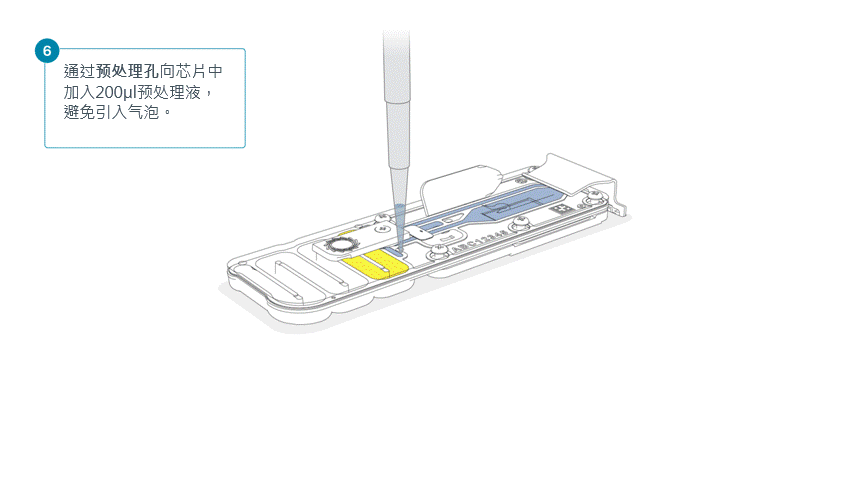
临上样前,用移液枪轻轻吹打混匀制备好的文库。
通过SpotON加样孔向芯片中逐滴加入75µl样品。确保液滴流入孔内后,再加下一滴。

轻轻合上SpotON加样孔孔盖,确保塞头塞入加样孔内。逆时针转动预处理孔孔盖,盖上预处理孔。


重要
为获得最佳测序产出,在文库样本上样后,请立即在测序芯片上安装遮光片。
我们建议在清洗芯片并重新上样时,将遮光片保留在测序芯片上。一旦文库从测序芯片中吸出,即可取下遮光片。
按下述步骤安装测序芯片遮光片:
小心将遮光片的前沿(平端)与金属固定夹的边沿对齐。 请注意: 请勿将遮光片强行压到固定夹下方。
将遮光片轻轻盖在测序芯片上。遮光片的SpotON加样孔孔盖缺口应与芯片上的SpotON加样孔孔盖接合,遮盖住整个测序芯片的前部。

注意
MinION测序芯片的遮光片并非固定在测序芯片上,因此当为芯片加装遮光片后,请小心操作。
步骤结束
小心合上测序设备上盖并在MinKNOW上设置测序实验。
8. 数据采集和碱基识别
如何开始测序
在完成测序芯片的加样后,您即可在MinKNOW中启动测序实验。MinKNOW 软件负责仪器控制、数据采集以及实时碱基识别。有关设置和使用 MinKNOW 的详细信息,请参阅MinKNOW 实验指南。
您可以通过多种方式使用并设置MinKNOW:
- 在直接或远程连接到测序设备的计算机上。
- 直接在 GridION、MinION Mk1C 或 PromethION 24/48 测序设备上。
有关在测序设备上使用 MinKNOW 的更多信息,请参阅相应设备的用户手册:
在MinKNOW中启动测序:
1. 在 "开始 "(Start)页面上,选择 __开始测序__(Start Sequencing)。 
2. 输入实验详情:例如实验名称,测序芯片位置及样本ID。 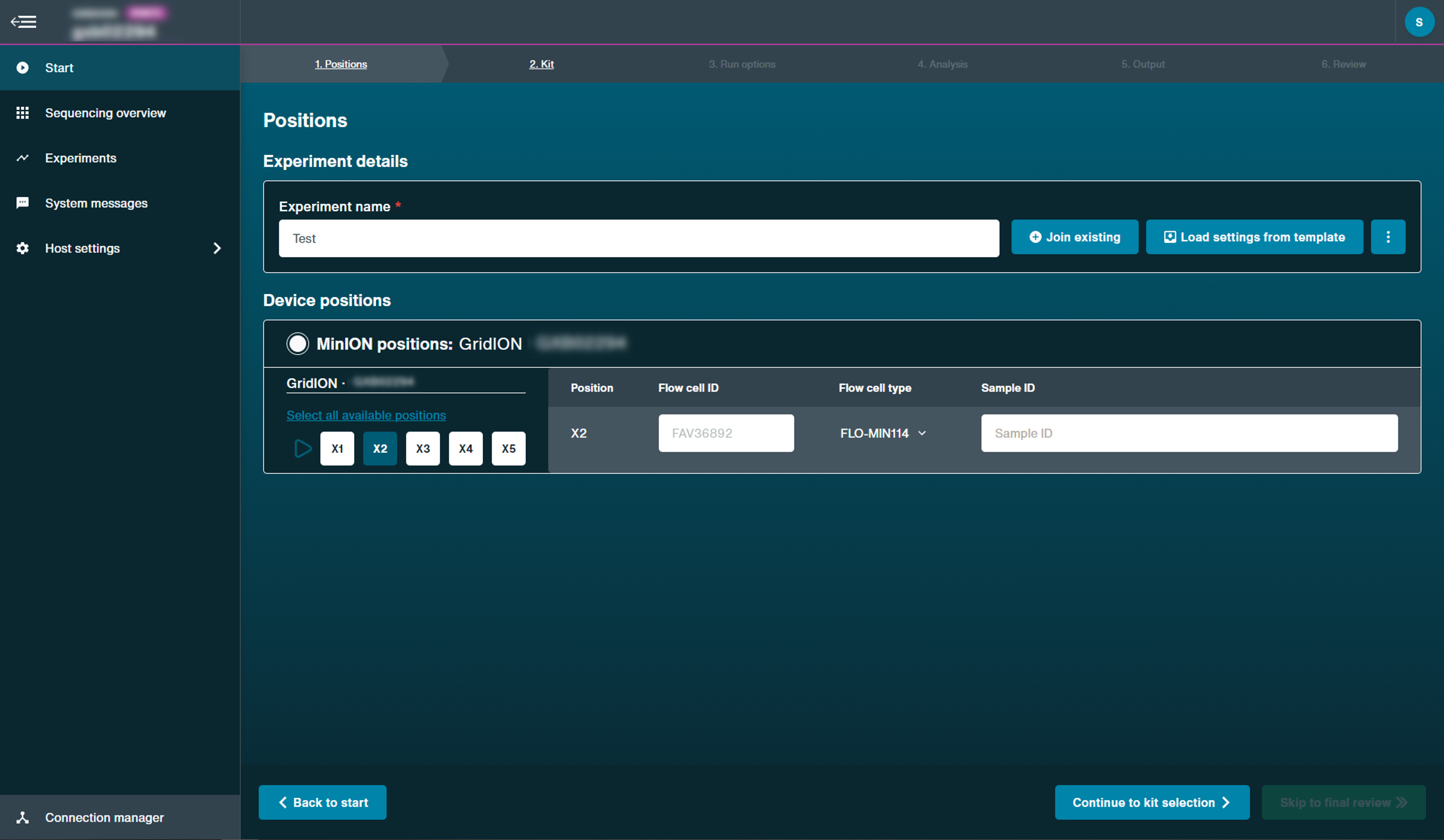
3. 在"试剂盒"页面上,选择建库试剂盒。 
4. 配置测序实验参数,或保持“运行选项”和“分析”页面中的默认设置。
请注意: 如果在设置运行参数时关闭了碱基识别,您可在实验结束后,在MinKNOW中运行线下碱基识别。详情请参阅MinKNOW实验指南。
5. 在“输出”页面中,设置输出参数或保持默认设置。 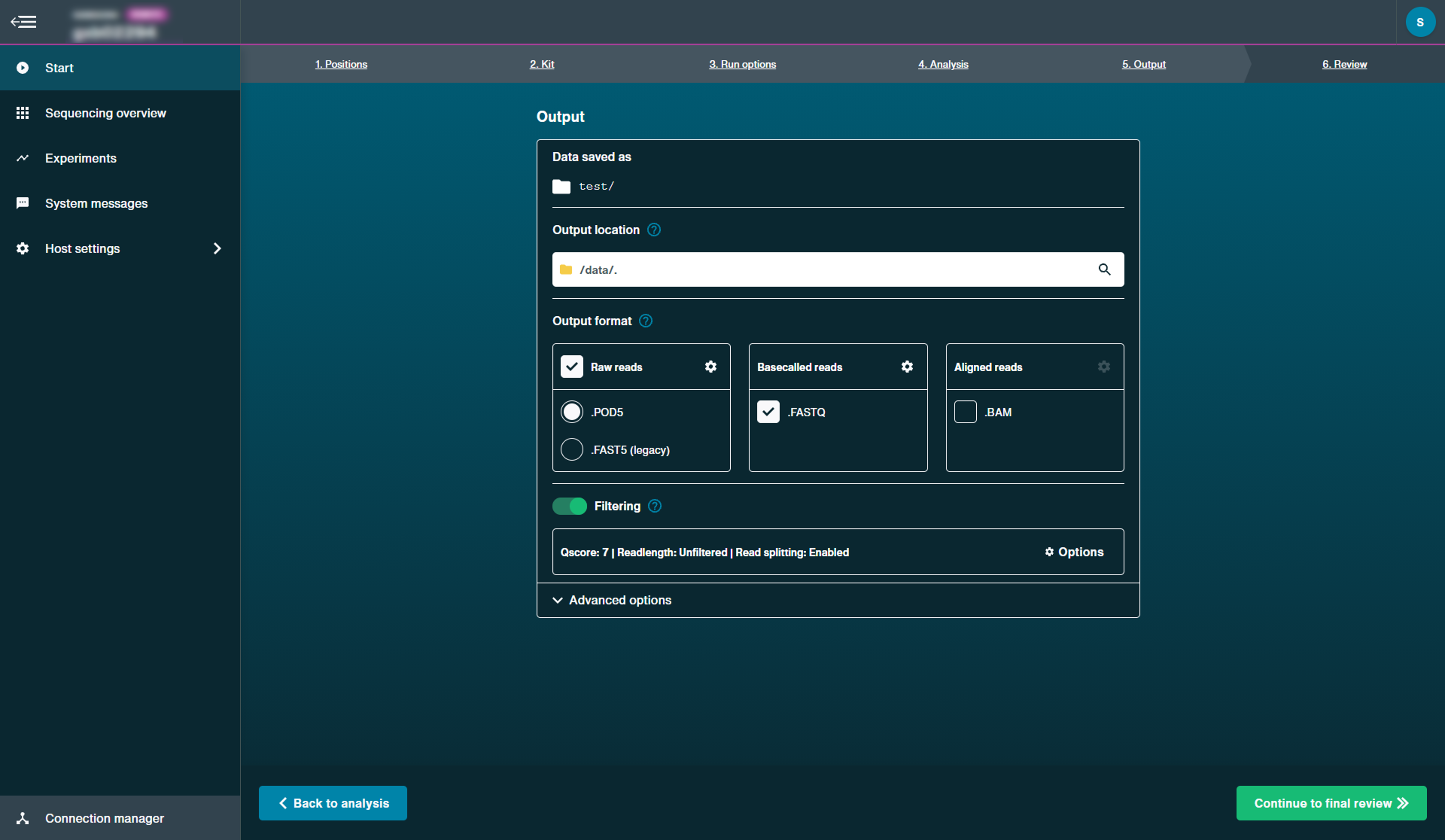
6. 单击 "参数确认" 页面上的 开始 启动测序。 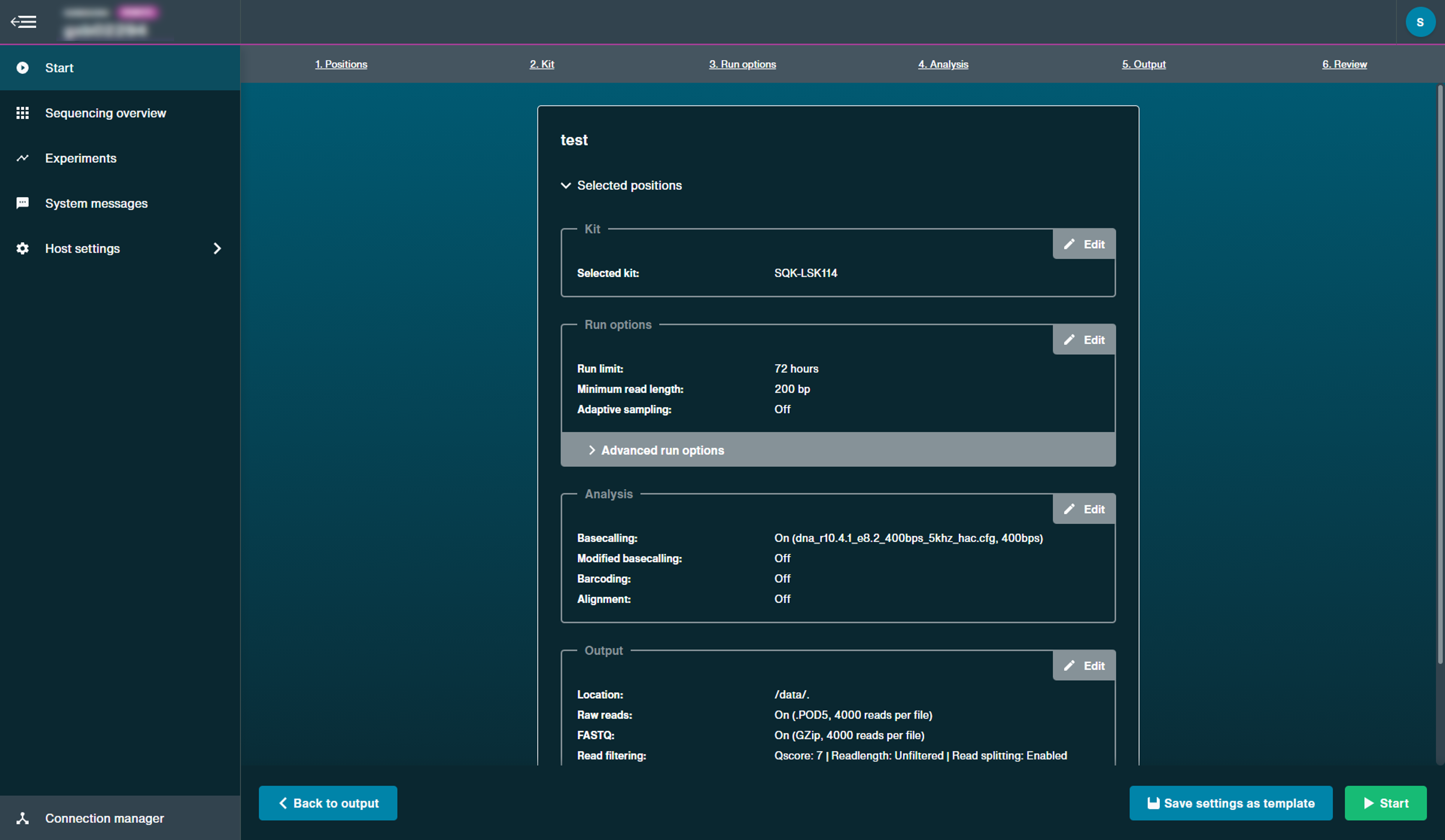
测序后数据分析
当于MinKNOW上完成测序后,您可按照“测序芯片的重复利用及回收”一节中的说明重复使用或返还测序芯片。
完成测序和碱基识别后,即可进行数据分析。有关碱基识别和后续分析选项的详细信息,请参阅数据分析文档。
在下游分析部分,我们将概述更多用于数据分析的选项。
9. 测序芯片的重复利用及回收
材料
- 测序芯片清洗剂盒(EXP-WSH004)
完成测序实验后,如您希望再次使用测序芯片,请按照测序芯片清洗试剂盒的说明进行操作,并将清洗后的芯片置于2-8℃保存。
您可在纳米孔社区获取 测序芯片清洗试剂盒实验指南。
提示
我们建议您在停止测序实验后尽快清洗测序芯片。如若无法实现,请将芯片留在测序设备上,于下一日清洗。
请按照“回收程序”清洗好芯片,以便送回Oxford Nanopore。
您可在 此处找到回收测序芯片的说明。
请注意: 在将测序芯片寄回之前,请使用去离子水对每张芯片进行冲洗。
重要
如果您遇到问题或对测序实验有疑问,请参阅本实验指南在线版本中的“疑难解答指南”一节。
10. 下游分析
下游分析
您可以选择以下几个途径来进一步分析经过碱基识别的数据:
1. EPI2ME 工作流程
Oxford Nanopore Technologies通过EPI2ME Labs平台提供了一系列针对高阶数据分析的生物信息学教程和工作流程。上述资源汇总于纳米孔社区的 EPI2ME Labs 板块。该平台通过描述性文字、生物信息学代码和示例数据,具象化地展示出我们的研究和应用团队发布在 GitHub 上的工作流程。
2. 科研分析工具
Oxford Nanopore Technologies的研发部门开发了许多分析工具,您可在Oxford Nanopore的 GitHub 资料库中找到。这些工具面向有一定经验的用户,并包含如何安装和运行软件的说明。工具以源代码形式提供,因此我们仅提供有限的技术支持。
3. 纳米孔社区用户开发的分析工具
如果以上工具仍无法为您提供解决研究问题的分析方法,请参考资源中心的生物信息学板块。该板块汇总了许多由纳米孔社区成员开发、且在Github上开源的、针对纳米孔数据的生信分析工具。请注意,Oxford Nanopore Technologies不为这些工具提供支持,也不能保证它们与测序所用的最新的化学试剂/软件配置兼容。
11. DNA/RNA提取和文库制备过程中可能出现的问题
以下表格列出了常见问题,以及可能的原因和解决方法。
我们还在 Nanopore 社区的“Support”板块 提供了常见问题解答(FAQ)。
如果以下方案仍无法解决您的问题,请通过电邮(support@nanoporetech.com))或微信公众号在线支持(NanoporeSupport)联系我们。
低质量样本
| 现象 | 可能原因 | 措施及备注 |
|---|---|---|
| 低纯度DNA(Nanodrop测定的DNA吸光度比值260/280<1.8,260/230 <2.0-2.2) | 用户所使用的DNA提取方法未能达到所需纯度 | 您可在 污染物专题技术文档 中查看污染物对后续文库制备和测序实验的影响。请尝试其它不会导致污染物残留的 提取方法。 请考虑将样品再次用磁珠纯化。 |
| RNA完整度低(RNA完整值(RIN)<9.5,或rRNA在电泳凝胶上的条带呈弥散状) | RNA在提取过程中降解 | 请尝试其它 RNA 提取方法。您可在 RNA完整值专题技术文档 中查看更多有关RNA完整值(RIN)的介绍。更多信息,请参阅 DNA/RNA 操作 页面。 |
| RNA的片段长度短于预期 | RNA在提取过程中降解 | 请尝试其它 RNA 提取方法。 您可在 RNA完整值专题技术文档中查看更多有关RNA完整值(RIN)的介绍。更多信息,请参阅DNA/RNA 操作 页面。 我们建议用户在无RNA酶污染的环境中操作,并确保实验设备没有受RNA酶污染. |
经AMPure磁珠纯化后的DNA回收率低
| 现象 | 可能原因 | 措施及备注 |
|---|---|---|
| 低回收率 | AMPure磁珠量与样品量的比例低于预期,导致DNA因未被捕获而丢失 | 1. AMPure磁珠的沉降速度很快。因此临加入磁珠至样品前,请确保将磁珠重悬充分混匀。 2. 当AMPure磁珠量与样品量的比值低于0.4:1时,所有的DNA片段都会在纯化过程中丢失。 |
| 低回收率 | DNA片段短于预期 | AMPure磁珠量与样品量的比值越低,针对短片段的筛选就越严格。每次实验时,请先使用琼脂糖凝胶(或其他凝胶电泳方法)确定起始DNA的长度,并据此计算出合适的AMPure磁珠用量。  |
| 末端修复后的DNA回收率低 | 清洗步骤所用乙醇的浓度低于70% | 当乙醇浓度低于70%时,DNA会从磁珠上洗脱下来。请确保使用正确浓度的乙醇。 |
12. Issues during the sequencing run
以下表格列出了常见问题,以及可能的原因和解决方法。
我们还在 Nanopore 社区的“Support”板块 提供了常见问题解答(FAQ)。
如果以下方案仍无法解决您的问题,请通过电邮(support@nanoporetech.com))或微信公众号在线支持(NanoporeSupport)联系我们。
Mux扫描在测序起始时报告的活性孔数少于芯片质检时报告的活性孔数
| 现象 | 可能原因 | 措施及备注 |
|---|---|---|
| MinKNOW Mux 扫描在测序起始时报告的活性孔数少于芯片质检时报告的活性孔数 | 纳米孔阵列中引入了气泡 | 在对通过质控的芯片进行预处理之前,请务必排出预处理孔附近的气泡。否则,气泡会进入纳米孔阵列对其造成不可逆转地损害。 视频中演示了避免引入气泡的最佳操作方法。 |
| MinKNOW Mux 扫描在测序起始时报告的活性孔数少于芯片质检时报告的活性孔数 | 测序芯片没有正确插入测序仪 | 停止测序,将芯片从测序仪中取出,再重新插入测序仪内。请确保测序芯片被牢固地嵌入测序仪中,且达到目标温度。如用户使用的是GridION/PromethION测序仪,也可尝试将芯片插入仪器的其它位置进行测序。 |
| inKNOW Mux 扫描在测序起始时报告的活性孔数少于芯片质检时报告的活性孔数 | 文库中残留的污染物对纳米孔造成损害或堵塞 | 在测序芯片质检阶段,我们用芯片储存缓冲液中的质控DNA分子来评估活性纳米孔的数量。而在测序开始时,我们使用DNA文库本身来评估活性纳米孔的数量。因此,活性纳米孔的数量在这两次评估中会有约10%的浮动。 如测序开始时报告的孔数明显降低,则可能是由于文库中的污染物对膜结构造成了损坏或将纳米孔堵塞。用户可能需要使用其它的DNA/RNA提取或纯化方法,以提高起始核酸的纯度。您可在 污染物专题技术文档中查看污染物对测序实验的影响。请尝试其它不会导致污染物残留的 提取方法 。 |
MinKNOW脚本失败
| 现象 | 可能原因 | 措施及备注 |
|---|---|---|
| MinKNOW显示 "Script failed”(脚本失败) | 重启计算机及MinKNOW。如问题仍未得到解决,请收集 MinKNOW 日志文件 并联系我们的技术支持。 如您没有其他可用的测序设备,我们建议您先将装有文库的测序芯片置于4°C 储存,并联系我们的技术支持团队获取进一步储存上的建议。 |
Pore occupancy below 40%
| Observation | Possible cause | Comments and actions |
|---|---|---|
| Pore occupancy <40% | Not enough library was loaded on the flow cell | Ensure you load the recommended amount of good quality library in the relevant library prep protocol onto your flow cell. Please quantify the library before loading and calculate mols using tools like the Promega Biomath Calculator, choosing "dsDNA: µg to pmol" |
| Pore occupancy close to 0 | The Ligation Sequencing Kit was used, and sequencing adapters did not ligate to the DNA | Make sure to use the NEBNext Quick Ligation Module (E6056) and Oxford Nanopore Technologies Ligation Buffer (LNB, provided in the sequencing kit) at the sequencing adapter ligation step, and use the correct amount of each reagent. A Lambda control library can be prepared to test the integrity of the third-party reagents. |
| Pore occupancy close to 0 | The Ligation Sequencing Kit was used, and ethanol was used instead of LFB or SFB at the wash step after sequencing adapter ligation | Ethanol can denature the motor protein on the sequencing adapters. Make sure the LFB or SFB buffer was used after ligation of sequencing adapters. |
| Pore occupancy close to 0 | No tether on the flow cell | Tethers are adding during flow cell priming (FLT/FCT tube). Make sure FLT/FCT was added to FB/FCF before priming. |
读长短于预期
| 现象 | 可能原因 | 措施及备注 |
|---|---|---|
| 读长短于预期 | DNA样本降解 | 读长反映了起始DNA片段的长度。起始DNA在提取和文库制备过程中均有可能被打断。 1. 1. 请查阅纳米孔社区中的 提取方法 以获得最佳DNA提取方案。 2. 在进行文库制备之前,请先跑电泳,查看起始DNA片段的长度分布。 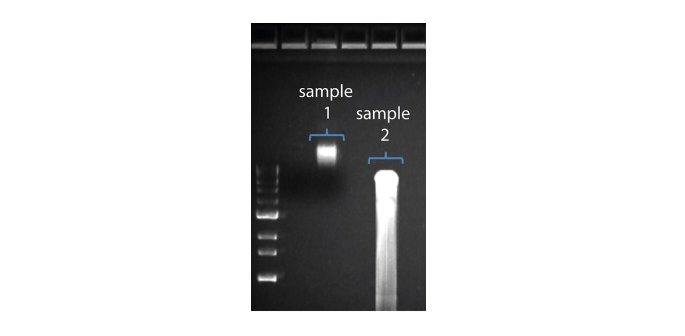 在上图中,样本1为高分子量DNA,而样本2为降解样本。 在上图中,样本1为高分子量DNA,而样本2为降解样本。3. 在制备文库的过程中,请避免使用吹打或/和涡旋振荡的方式来混合试剂。轻弹或上下颠倒离心管即可。 |
大量纳米孔处于不可用状态
| 现象 | 可能原因 | Comments and actions |
|---|---|---|
大量纳米孔处于不可用状态 (在通道面板和纳米孔活动状态图上以蓝色表示)  上方的纳米孔活动状态图显示:状态为不可用的纳米孔的比例随着测序进程而不断增加。 上方的纳米孔活动状态图显示:状态为不可用的纳米孔的比例随着测序进程而不断增加。 | 样本中含有污染物 | 使用MinKNOW中的“Unblocking”(疏通)功能,可对一些污染物进行清除。 如疏通成功,纳米孔的状态会变为"测序孔". 若疏通后,状态为不可用的纳米孔的比例仍然很高甚至增加: 1. 用户可使用 测序芯片冲洗试剂盒(EXP-WSH004)进行核酸酶冲洗 can be performed, 操作,或 2. 使用PCR扩增目标片段,以稀释可能导致问题的污染物。 |
大量纳米孔处于失活状态
| 现象 | 可能原因 | 措施及备注 |
|---|---|---|
| 大量纳米孔处于失活状态(在通道面板和纳米孔活动状态图上以浅蓝色表示。膜结构或纳米孔遭受不可逆转地损伤) | 测序芯片中引入了气泡 | 在芯片预处理和文库上样过程中引入的气泡会对纳米孔带来不可逆转地损害。请观看 测序芯片的预处理及上样 视频了解最佳操作方法。 |
| 大量纳米孔处于失活/不可用状态 | 文库中存在与DNA共纯化的化合物 | 与植物基因组DNA相关的多糖通常能与DNA一同纯化出来。 1. 请参考 植物叶片DNA提取方法。 2. 使用QIAGEN PowerClean Pro试剂盒进行纯化。 3. 利用QIAGEN REPLI-g试剂盒对原始gDNA样本进行全基因组扩增。 |
| 大量纳米孔处于失活/不可用状态 | 样本中含有污染物 | 您可在 污染物专题技术文档 中查看污染物对测序实验的影响。请尝试其它不会导致污染物残留的提取方法。 |
运行过程中过孔速度和数据质量(Q值)降低
| 现象 | 可能原因 | 措施及备注 |
|---|---|---|
| 运行过程中过孔速度和数据质量(Q值)降低 | 对试剂盒9系列试剂(如SQK-LSK109),当测序芯片的上样量过多时(请参阅相应实验指南获取推荐文库用量),能量消耗通常会加快。 | 请按照MinKNOW 实验指南中的说明为测序芯片补充能量。请在后续实验中减少测序芯片的上样量。 |
温度波动
| 现象 | 可能原因 | 措施及备注 |
|---|---|---|
| 温度波动 | 测序芯片和仪器接触不良 | 检查芯片背面的金属板是否有热垫覆盖。重新插入测序芯片,用力向下按压,以确保芯片的连接器引脚与测序仪牢固接触。如问题仍未得到解决,请联系我们的技术支持。 |
未能达到目标温度
| 现象 | 可能原因 | 措施及备注 |
|---|---|---|
| MinKNOW显示“未能达到目标温度” | 测序仪所处环境低于标准室温,或通风不良(以致芯片过热) | MinKNOW会限定测序芯片达到目标温度的时间。当超过限定时间后,系统会显示出错信息,但测序实验仍会继续。值得注意的是,在错误温度下测序可能会导致通量和数据质量(Q值)降低。请调整测序仪的摆放位置,确保其置于室温下、通风良好的环境中后,再在MinKNOW中继续实验。有关MinION MK1B温度控制的更多信息,请参考此 FAQ (常见问题)文档。 |
Guppy – no input .fast5 was found or basecalled
| Observation | Possible cause | Comments and actions |
|---|---|---|
| No input .fast5 was found or basecalled | input_path did not point to the .fast5 file location | The --input_path has to be followed by the full file path to the .fast5 files to be basecalled, and the location has to be accessible either locally or remotely through SSH. |
| No input .fast5 was found or basecalled | The .fast5 files were in a subfolder at the input_path location | To allow Guppy to look into subfolders, add the --recursive flag to the command |
Guppy – no Pass or Fail folders were generated after basecalling
| Observation | Possible cause | Comments and actions |
|---|---|---|
| No Pass or Fail folders were generated after basecalling | The --qscore_filtering flag was not included in the command | The --qscore_filtering flag enables filtering of reads into Pass and Fail folders inside the output folder, based on their strand q-score. When performing live basecalling in MinKNOW, a q-score of 7 (corresponding to a basecall accuracy of ~80%) is used to separate reads into Pass and Fail folders. |
Guppy – unusually slow processing on a GPU computer
| Observation | Possible cause | Comments and actions |
|---|---|---|
| Unusually slow processing on a GPU computer | The --device flag wasn't included in the command | The --device flag specifies a GPU device to use for accelerate basecalling. If not included in the command, GPU will not be used. GPUs are counted from zero. An example is --device cuda:0 cuda:1, when 2 GPUs are specified to use by the Guppy command. |


